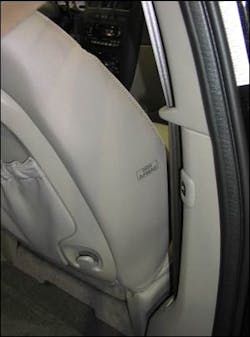The most common obstruction that blocks the airbag ID and causes responders to not realize that the seat their patient is sitting on has an airbag within it is the vehicle's B-pillar.
As automakers continue with each model year, to introduce more and more vehicles with side impact airbags, the chances of an emergency responder encountering a crash-damaged vehicle with an undeployed side airbag gets even greater. Remember, the airbags on the impact side are the ones that generally deploy. The side impact airbags on the side opposite the collision remain 'loaded'. There is an important lesson to be learned and remembered by all responders regarding one type of side impact airbag: the seat-mounted design.
Seat-mounted side impact airbags can be found in front seats and even the rear seats in some vehicles. There is even an SUV with a fold-down second row seat that has a seat-mounted airbag in its' moveable seatback.
All seat airbags are in the upright portion of the seatback, along the outboard edge. Seat-mounted airbags also have some sort of airbag ID to indicate the presence of the airbag in the seat. The caution for responders, especially EMS personnel who are right within a seat airbag's inflation zone when making patient contact, is that not all seat airbag IDs will be readily visible. You'll have to do a little detective work to see if you have an airbag or not this time.
The most common obstruction that blocks the airbag ID and causes responders to not realize that the seat their patient is sitting on has an airbag within it is the vehicle's B-pillar. The normal position of a seatback places the outboard edge of the seat right along the side of the B-pillar. It is the pillar and possibly even the seatbelt itself that can block your view.
Crash Course Teaching Point: Anticipate that every seat in every vehicle has a seat airbag that is loaded and aimed right at you until proven otherwise. Move around and do a good job looking along the outboard edge of the seat or along the outer edge of the seat cushion itself to see if in fact, you can locate an airbag ID. The typical seat airbag inflation zone is five inches thick with an inflated height potentially making it capable of touching the edge of the roofline.
Be Informed...Be Ready...Beware!
RON MOORE, a Firehouse.com Contributing Editor, is a battalion chief/fire training officer for the McKinney, TX, Fire Department. He is the author of the University of Extrication series, featured each month in Firehouse Magazine and is the moderator of the University of Extrication interactive forums on Firehouse.com. In 1984, he received the International Society of Fire Service Instructors George D. Post Instructor of the Year award for development of the first school bus rescue training program in the United States. In 2000, Ron was awarded the International Association of Fire Chief's "Excellence in Rescue" award. Ron has presented two Firehouse.com TrainingLIVE webcasts: The Top 10 Challenges of Vehicle Rescue Today and U of E: School Bus Emergencies To read Ron's complete biography and view his archived articles, click here. You can reach Ron by e-mail at [email protected].






